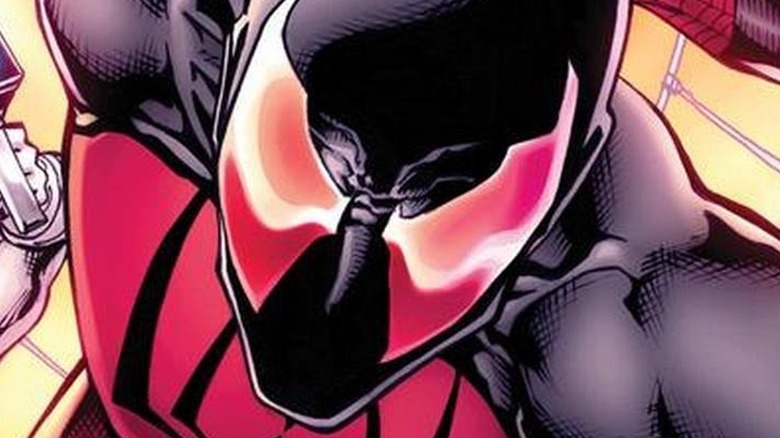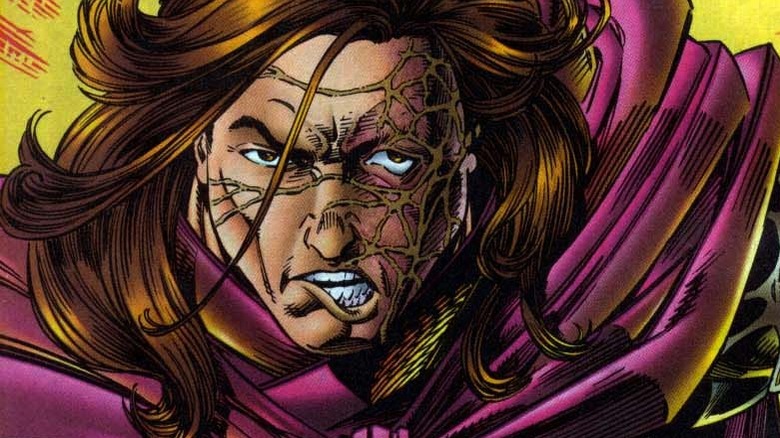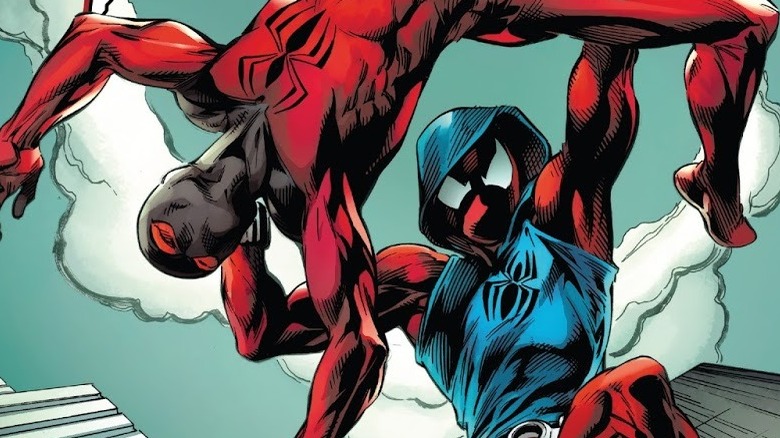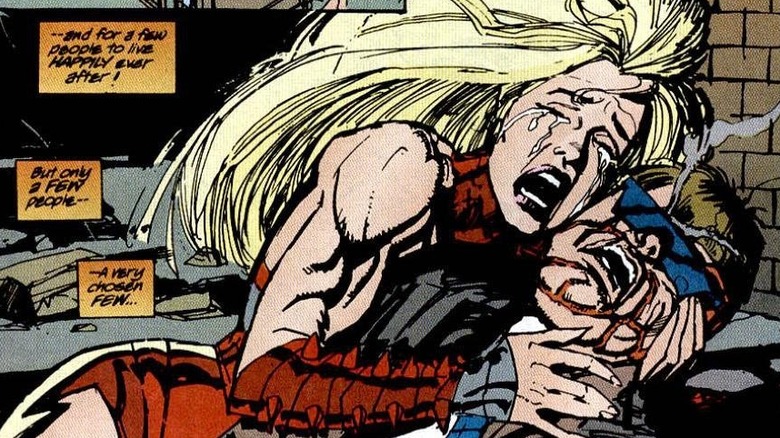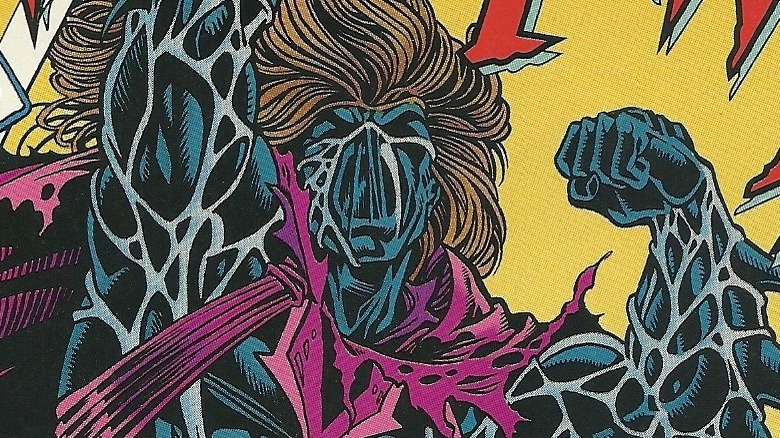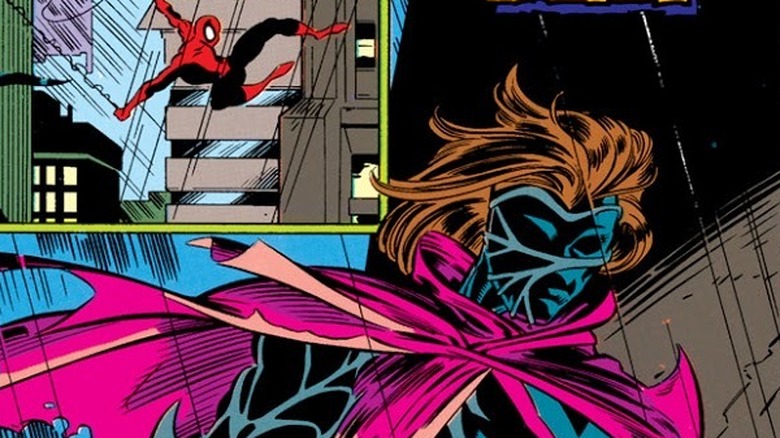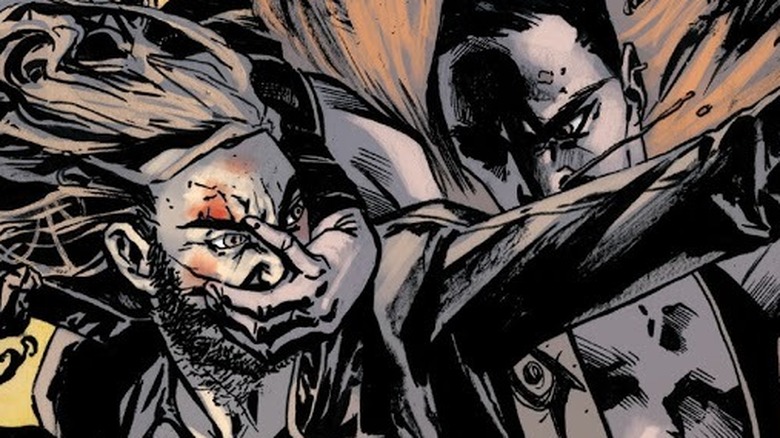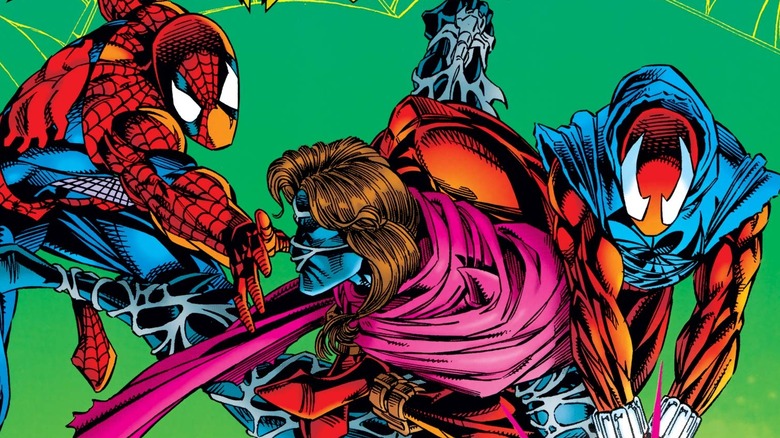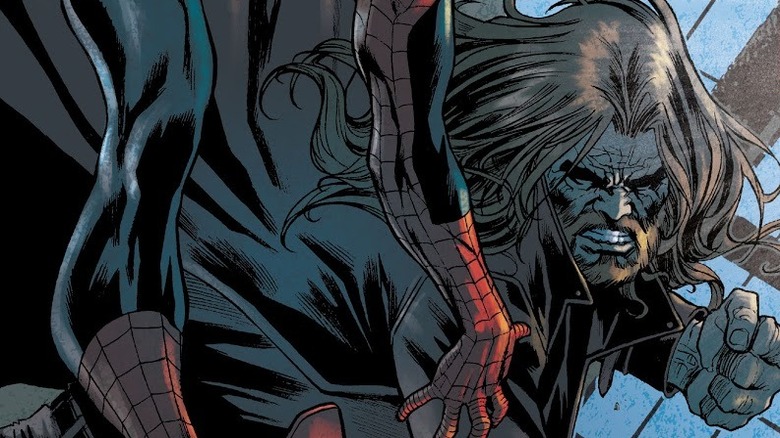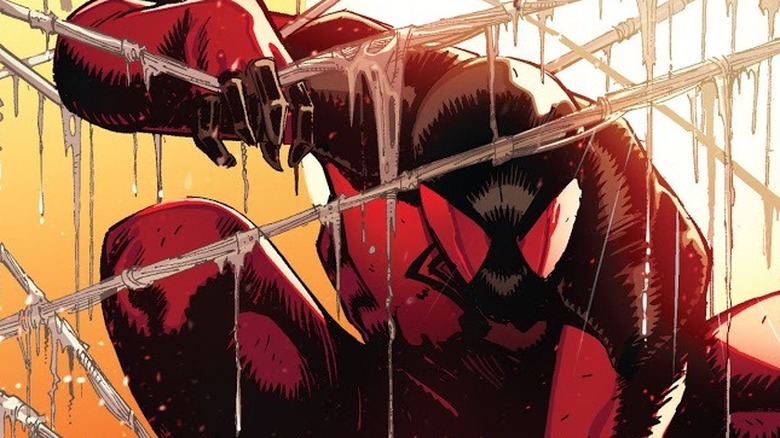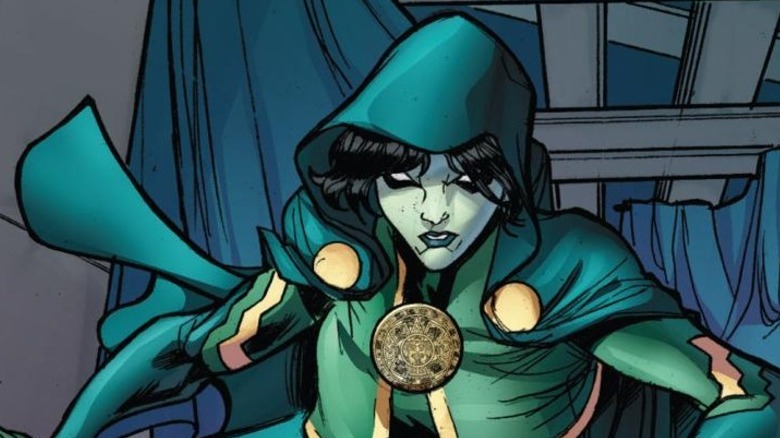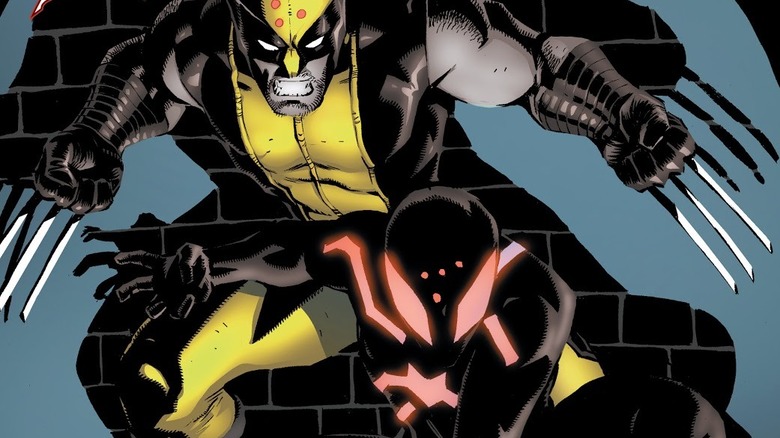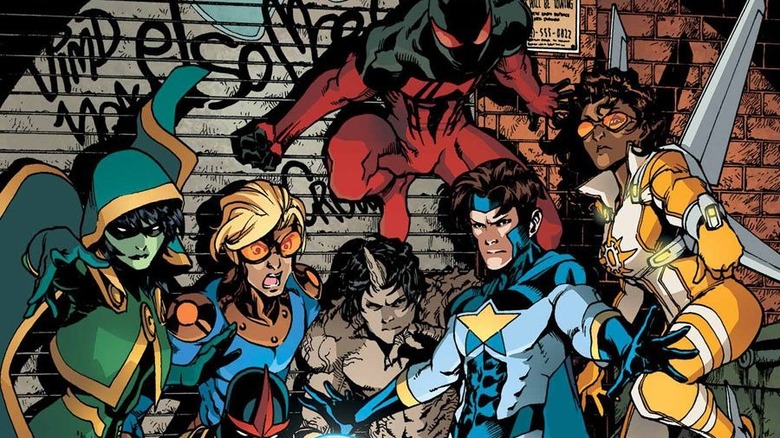The Untold Truth Of Marvel's Kaine
Whenever somebody brings up the '90s Clone Saga that pretty much engulfed Spider-Man comic books for more than two years, Peter Parker's clone, Ben Reilly, is usually the first thing that comes to mind. Despite the generally negative reaction to the massive comic book story arc (especially in terms of how Marvel stretched it well beyond its reasonable limits), Spider-Man's genetic duplicate turned out to be one of its few bright spots. Proof of this is the fact that he gained his own following, sufficiently proving his commercial viability and paving the way for his return in 2016's "Dead No More: The Clone Conspiracy."
However, Ben isn't the only Spider-clone to successfully carve a place for himself in the Spider-fandom. Another clone of Peter's — essentially a bigger, badder version of Spider-Man — started out as a foil for both him and Ben, but gradually evolved into one of Marvel's most uniquely complex antiheroes. Here is the untold truth of Marvel's Kaine.
Kaine: Peter Parker's first successful (but imperfect) clone
Kaine's debut in 1994's "Web of Spider-Man" #119 established him as an enigmatic, extremely dangerous new player in Spider-Man's world. In the issue, the mysterious assassin made short work of a roomful of armed criminals. Notably, Kaine grabbed one of the goons and snapped his neck, leaving a permanent mark on his face.
In the 35-part retrospective essay Life of Reilly, former Marvel writer Glenn Greenberg shared that the Spider-Man creative team had major plans for Kaine — and that they were very secretive about the character's true identity. "I didn't know who he really was at this point — even Mark [Bernardo, Spider-Man assistant editor,] wouldn't tell me at first. I think he wanted me to read the stories as they came out so that he could see my natural, unprepared reaction when Kaine's identity was finally revealed."
Subsequent developments in the Clone Saga revealed that Kaine was actually the Jackal's first attempt at cloning Peter Parker, existing even before Ben Reilly's first appearance in "Amazing Spider-Man" #149. A failed genetic experiment suffering from the effects of cellular breakdown, Kaine had to wear his dark, veiny full-body suit to stay alive. Greenberg described the costume as "a life-support outfit that stabilized the debilitating effects of his cellular degeneration." When unmasked, Kaine looked almost like a dead ringer for Peter — that is, if Peter had long hair and a massive scar on his face.
Kaine was really obsessed with Ben Reilly
In Kaine's early appearances, he seemed to tread the fine line between hero and villain. As time went on, though, one thing became abundantly clear: He hated Ben Reilly with a passion — for a rather convoluted reason.
For half of the Clone Saga, writers dangled a question in front of readers: Is Peter Parker the real Spider-Man, or is it Ben? In 1995's "Spectacular Spider-Man" #226, Ben is shown to be the original — meaning the Spider-Man that fans had been following for two decades was the duplicate. This also explained why Kaine hated Ben enough to stalk him and frame him for multiple murders (as Kaine himself confirmed in "Web of Spider-Man" #126): Believing Peter to be the duplicate, Kaine wanted Ben out of the picture so that even if Kaine himself couldn't live a normal life, at least his fellow clone could. However, the Clone Saga's conclusion ("Spider-Man" #75) revealed that this was all a meticulous ruse by the Green Goblin, and that Peter was, in fact, the true Spider-Man.
Over time, Kaine dropped his vendetta against Ben — only to pick it up again for a different reason. In 2017's "Clone Conspiracy: Omega" one-shot, Kaine decided to track down Ben who, driven insane by multiple resurrections, came up with a scheme to clone Peter's dead friends and foes. Eventually, the two clone brothers hashed out their differences, and have since been on somewhat amicable terms.
To make Kaine a big deal, a Spider-villain bit the dust
To help build up Kaine's rep in the Spider-books, writers decided to have him off some of Spider-Man's rogues. Unfortunately, among the Spider-foes they placed on the chopping block was one of Peter's oldest and greatest enemies, Doctor Octopus — and to add insult to injury, it was right after the villain saved Peter's life.
"Spectacular Spider-Man" #221 concluded the four-part "Web of Death" story, which showed Peter nearly dying after being poisoned. Unwilling to let his hated opponent die by someone else's hands, Doc Ock exerts tremendous effort to cure Peter and bring him back to life. Doc Ock's cure works, and he willingly surrenders to the police, expressing his intent to fight Spider-Man once again when he's fully recovered. However, Kaine gets to Doc Ock before his planned escape — and ends the villain's life by snapping his neck and scarring his face.
Glenn Greenberg reminisced that this was meant to be "a dramatic high point," and that Doc Ock's demise was supposed to last (via Life of Reilly). He wasn't thrilled by this decision, though: "I'm not a big fan of killing off major villains, especially classic ones like Doctor Octopus, and I had serious doubts that a character of his stature and history could ever be suitably replaced by a new villain." Sure enough, "Amazing Spider-Man" #427 resurrected Doc Ock through a mystical ceremony, reestablishing him as a deadly Spider-foe.
Kaine: Spider-Man dialed up to 11
As the imperfect clone of Peter Parker, Kaine initially suffered from a genetic degenerative disease that left him in never-ending agony. However, Kaine also received some gifts that Ben didn't: The clone degeneration actually boosted the spider-powers Kaine got from their mutual progenitor.
In his many appearances in the comics, Kaine has been depicted as bigger, tougher, quicker, and more agile than both Peter and Ben. As Glenn Greenberg explains (in Life of Reilly): "All of Kaine's powers were enhanced versions of Peter's powers. It was well-established in the stories that Kaine was physically stronger than Peter, and he was clearly much taller and more massive." In addition, his Spider-Sense worked a bit differently: Instead of simply warning him of impending danger within his vicinity, Kaine actually received "visions" of significant future events. Meanwhile, his ability to scar his targets' faces with a mere touch of his hand (aka the Mark of Kaine) was "just a greatly enhanced version of the 'stick-to-walls' ability that Peter possesses in his hands and feet."
Subsequent developments in Kaine's life healed his degenerative disease, but also cost him some of these abilities. As shown in 2012's "Scarlet Spider" #7, Kaine lost both his enhanced and regular Spider-Sense. In order to dodge attacks from opponents and avoid danger around him, Kaine relied only on his agility and reflexes — which is the exact same way future Spider-Man Miguel O'Hara survived his costumed exploits in the year 2099.
Kaine was (initially) too badass for his own good
If you have a character as popular and profitable as Spider-Man, it's reasonable to assume that his spin-off characters could reach similar levels of success. At least, that's how the writers of the Clone Saga looked at Kaine. "As I mentioned before, there was a lot of talk about Kaine at this point, his future potential as a franchise character," confirmed Glenn Greenberg in his Life of Reilly commentary. "There were discussions about possibly spinning him off eventually into his own title, the way Venom had been."
Proof of this is how Kaine was repeatedly depicted as having little trouble dispatching enemies that normally gave Spider-Man a hard time. In fact, in 1995's "Spider-Man Unlimited" #9, a group of Spider-Man's foes — Hobgoblin, Beetle, Shocker, Electro, Mysterio, Scorpia, and a temporarily youthful Vulture — form the Sinister Seven out of fear that one of them might be Kaine's next target.
Unfortunately, Kaine's badassery proved to be his character's undoing, according to Greenberg: "Tom Brevoort and I privately agreed that a character as brutal and murderous as Kaine had been portrayed up to that point could not easily be 'rehabilitated' and suddenly made into a protagonist." In "Spectacular Spider-Man" #227, Kaine was shown dying brutally at the hands of Spidercide, another demented Peter Parker clone. However, his story didn't end here, as his creator, the Jackal, placed his remains in a regeneration pod, paving the way for the clone's return.
Kaine accidentally caused one of Peter's worst experiences
After the conclusion of the Clone Saga, Kaine became less of a presence in Marvel's books, making only sporadic appearances from time to time. While this was a sign that Kaine's time in the spotlight had come to an end, it also meant that there were plenty of gaps in his story to fill, should he ever make his return in the Spider-books. That's what "Hunting the Hunter," a backup story that ran in the four-part "Grim Hunt," accomplished: It showed an untold tale from Kaine's past that contributed to one of the most painful predicaments Peter Parker ever endured.
Years ago, Kraven the Hunter refused to complete a hit job, after his target turned out to be a coward who barely challenged his skills. In retaliation, the crime boss who hired Kraven enlisted the services of Kaine to kill him. Kaine agreed not only for the money, but also because of a vision that showed Kraven killing him. The two men fought, with Kaine getting the upper hand and burying Kraven alive. After three days, Kraven was able to free himself.
The conclusion strongly hinted that Kraven's ordeal drove him mad, leading to the events of the critically acclaimed "Kraven's Last Hunt." In the 6-part story, Kraven buries Spider-Man alive, pretending to be him for two weeks. Peter digs his way out, but Kraven confesses his crimes and takes his own life before Peter can bring him to justice.
Writers nailed many details about Kaine -- but forgot to use them
During the Clone Saga, Kaine was intentionally written to be mysterious, often committting acts of violence against both heroes and villains for reasons known only to him. Unfortunately, what was meant to be the build-up for a possible Spider-Man spin-off got lost in the discombobulated crossover mess, to the point that even critical aspects of Kaine's character were never fully explained in the Spider-books.
As Glenn Greenberg explained in his interviews with writer Andrew Goletz, many of the interesting aspects of Kaine's character — from his costume to his powers — were never fully explained in the comics: "Ironically enough, as Mark Bernardo — even to this day — has never failed to point out, NONE of the Spider-writers ever managed to work any of this information into the actual stories!" Greenberg also lamented the fact that only their "little group" of Spider-scribes knew all of these things about Kaine.
Interestingly, the writer who was able to flesh out Kaine's story the most wasn't even the person who thought him up in the first place. Greenberg noted that while it was writer Howard Mackie who "came up with the idea of Kaine," most of his character development came from J.M. DeMatteis' pen: "Whenever Kaine appeared in a DeMatteis story, there was a depth and three-dimensional quality to him that was just wasn't there in the other writers' stories."
Peter Parker's deal with Mephisto didn't affect Kaine
In the aftermath of Marvel's "Civil War," Peter Parker and Mary Jane Watson strike a deal with the demon Mephisto, sacrificing their marriage to make the entire world forget Spider-Man's secret identity. However, "Amazing Spider-Man" #608 shows that the Devil's magic doesn't work on everyone, as Kaine makes a surprising return to Peter Parker's life and reveals that he still remembers his progenitor's true name.
When a villain calling himself Raptor shows up and accuses Peter of committing crimes under the name "Ben Reilly," Spider-Man is compelled to dig into exactly what his clone was up to when he was still alive. During his search for answers, he encounters Kaine, who confirms that he still knows Spider-Man's real identity. Kaine antagonizes Peter during this story, revealing that he was the true culprit behind the crimes Raptor pinned on Ben.
Later stories would show that Kaine inherited not just Peter's amazing spider-powers, but his sense of heroism as well. In "Amazing Spider-Man" #635, Kaine pretends to be Peter to save him from death at the hands of the Kravinoff family. However, he is almost immediately resurrected as a mutated human-spider hybrid, leading to the next chapter in the clone's tortured existence.
Kaine took on the mantle of his clone brother
Interestingly, it took nearly two decades in real-world time before Marvel's initial intent for Kaine could come to fruition.
In the 2011 comic book event "Spider-Island," Kaine endures a full transformation into a half-man, half-spider monster. By the story's conclusion, Kaine reverts to human form, while also being completely healed of his degenerative disease and facial scars. He joins Spider-Man in the final battle, clad in the technologically advanced "Big Time" suit that Peter developed for his own use. "Amazing Spider-Man" #673 shows Kaine leaving New York, but not before having a quick conversation with Peter: Due to a warning from the spider-themed clairvoyant Madame Web, he intends to bring the special costume with him to wherever he's going.
Marvel's 2011 "Point One" one-shot shows Kaine constantly denying to himself that he's cut from the same heroic cloth as Peter. However, he ultimately suits up and stops a bank robbery, deciding to give the hero's life a try. By issue 5 of Kaine's solo title, the media starts calling his red-clad alter ego the Scarlet Spider — the same codename his clone brother, Ben Reilly, used to go by.
Meet Kaine's psychic sidekick, Hummingbird
When Kaine initially decided to get into superheroics, he planned to do so alone. However, one of his first good deeds as the Scarlet Spider ended up gaining him a powerful sidekick, as shown in "Scarlet Spider" #1.
En route to Mexico, Kaine stumbles upon a human trafficking operation in Houston, Texas. He overpowers the criminals and takes their money, but also finds shipping containers full of dead bodies. He finds only one survivor, a girl named Aracely. Kaine takes Aracely to the city hospital, but before he can leave, an assassin shows up, intending to kill her. In the process of saving her, Kaine decides to stay in Houston, becoming its resident superhero.
Later on, Kaine discovers that Aracely has powers: Aside from the ability to levitate and instantly learn other languages by reading people's minds, she can also detect and manipulate emotions. The latter proves to be extremely useful in battle, as she can cause opponents to suddenly become paralyzed with fear. In addition, she can telepathically communicate with allies. Much to Kaine's chagrin, Aracely adopts the superhero codename Hummingbird, complete with a green costume. After forming a psychic bond with Kaine, she becomes his constant companion, even after the hero decides to leave Texas (as seen in "Scarlet Spider" #25).
Kaine was sent to assassinate an X-Man
In an attempt to save his new friends and family in Texas from a dangerous organization he had previously run afoul of, Kaine offers to do one assassination job for them. Unfortunately, this deal pits him against perhaps the most lethal target of all: the X-Man known as Wolverine.
In "Scarlet Spider" #17, the Assassin's Guild summons Kaine, sending him to the Jean Grey School for Higher Learning to eliminate his target. Kaine and Aracely face off against some of the X-Men at the mansion, until Wolverine shows up to deal with the intruders himself. With the Guild's operatives watching outside the mansion, Kaine stabs Wolverine in the heart, seemingly killing the mutant. However, this turns out to be a ruse: The next issue reveals that Aracely and Kaine warned Wolverine and the X-Men telepathically about their mission, and asked them to play along until the spies from the Guild leave the school grounds.
The two ill-tempered antiheroes temporarily agree to work together, and leave the school to bring the fight to the Guild's doorstep. After Kaine and Wolverine find themselves in a bloody battle against the Guild, the ultimate puppeteer is revealed to be Candra, aka the Red Death, an immortal mutant that the X-Men fought years ago. Kaine and Wolverine defeat Candra and the Guild with some backup from the Kingpin, whom Kaine secretly made a deal with — further proof that Kaine isn't above forging alliances with shady characters.
Kaine: A reluctant superhero and team player
For all of Kaine's constant bellyaching about the spandex-clad superhero crowd, he has shown time and again that he can work with — and even hold his own against — the very best of them. After Kaine and Aracely decide to leave Texas in "Scarlet Spider" #25, they quickly find themselves mixed up in a massive conflict involving the High Evolutionary and the Celestials. Along the way, they team up with Justice, Speedball, Nova, Sun Girl, Faira Sar Namora, and Haechi to form the New Warriors.
Kaine has also worked with different spider-powered individuals to save the multiverse not once, but twice. In 2014, the "Spider-Verse" crossover event featured the Scarlet Spider working with Spider-Man, Miles Morales, Spider-Man 2099, Spider-Girl, and even Spider-Ham to fight the Inheritors, a family of dimension-hopping vampires specifically targeting "spider-totems" across the multiverse. Kaine's role as the host of the spider deity called The Other plays a major role in the conflict, as he dies (albeit temporarily) to help the Spiders achieve victory. The 2018 sequel event, "Spider-Geddon," shows Kaine being recruited by the Superior Spider-Man (Doc Ock in a cloned body of Peter Parker) to stop the Inheritors permanently.
